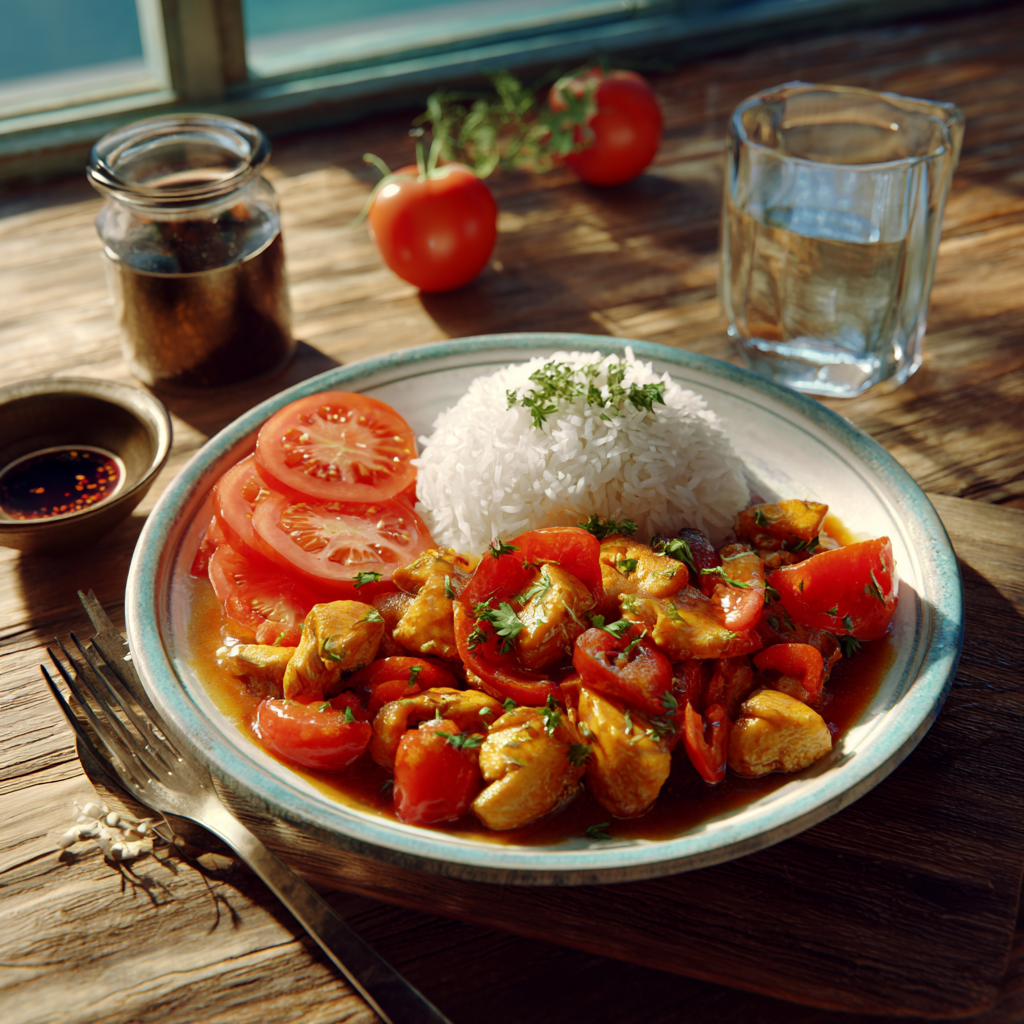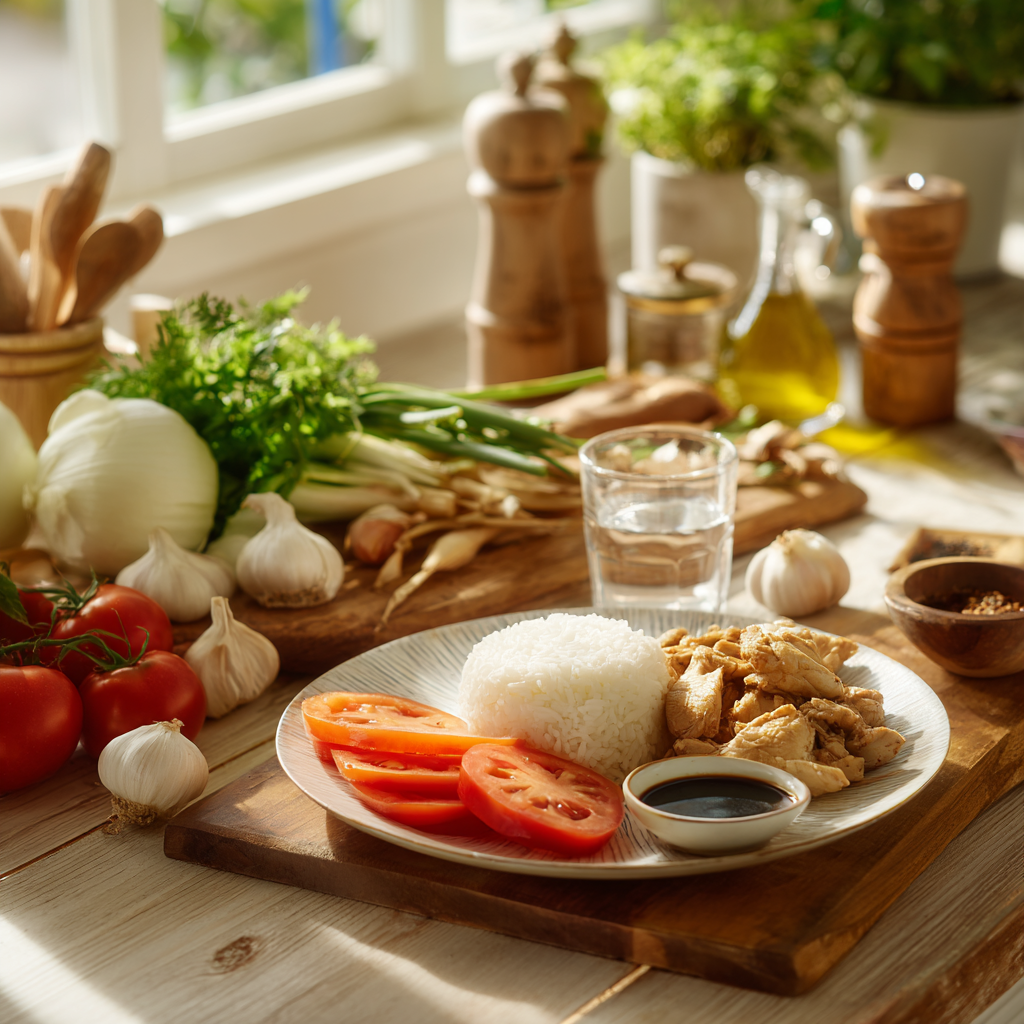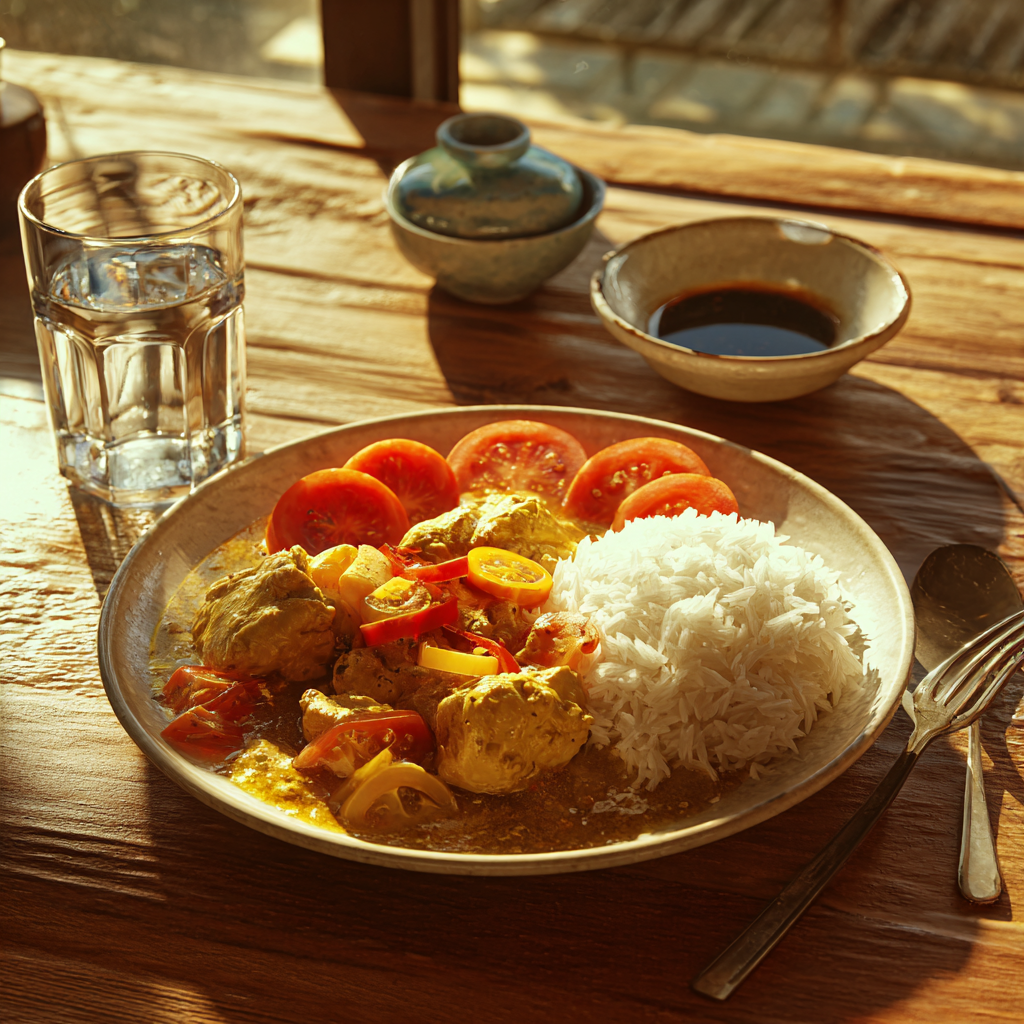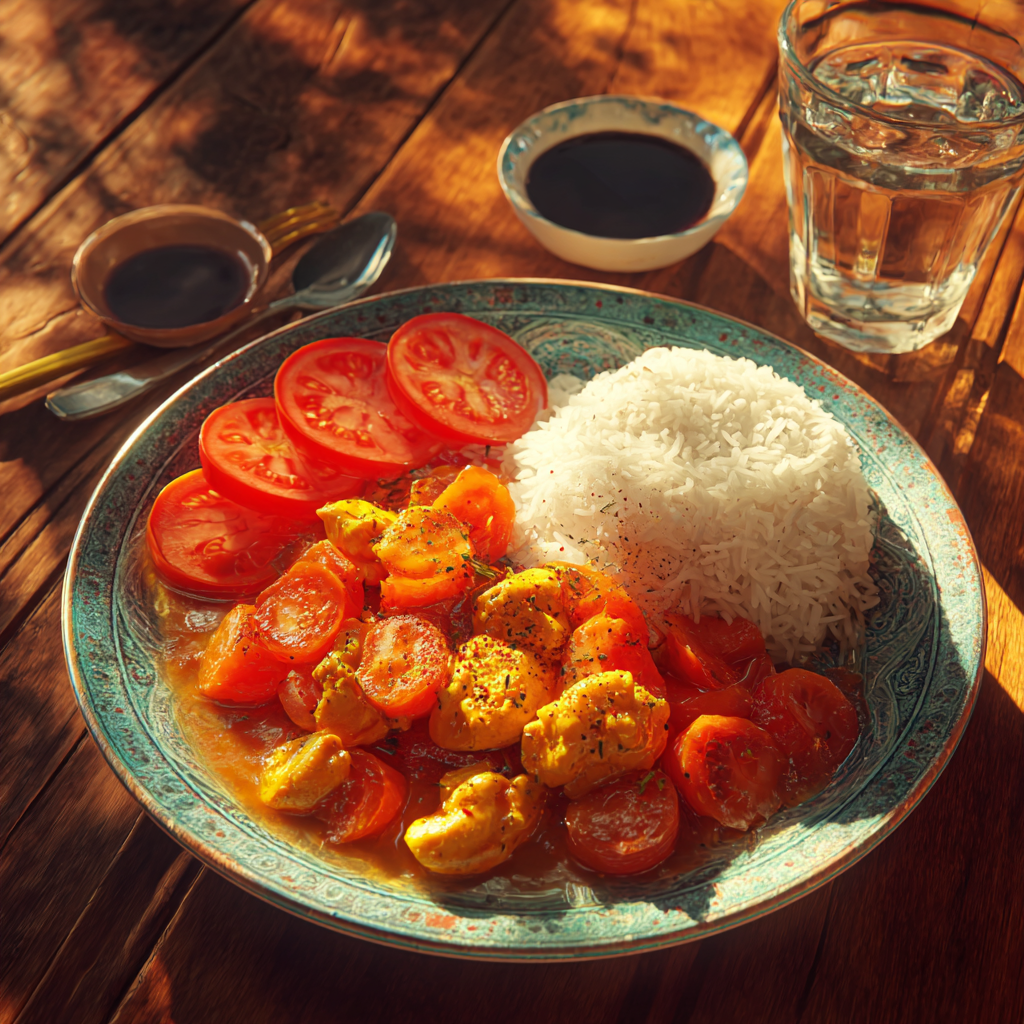
Introduction
I still remember the first time I smelled chicken curry simmering on my grandmother’s stove. The aroma of garlic, ginger, and spices filled the air, pulling everyone to the kitchen. Filipino cuisine holds a special place in my heart, and chicken curry is one dish that always stands out. It’s rich, comforting, and packed with flavor, yet it uses simple ingredients you can easily find at most grocery stores.
If you’re searching for an authentic Filipino recipe for chicken curry, you’ve come to the right place. This dish is perfect for home cooks in the USA who want to try something new without spending hours in the kitchen. With just a few key ingredients like coconut milk, turmeric, and garlic, you can bring the taste of the Philippines to your dinner table.
What Makes Filipino Chicken Curry Unique?
In Filipino households, chicken curry is more than just a meal—it’s a celebration of flavors passed down through generations. While curry dishes are popular worldwide, Filipino chicken curry has its own twist. Unlike Indian curries, which often use garam masala and cream, or Thai curries that lean heavily on lemongrass and coconut, Filipino chicken curry strikes a balance. It’s milder and sweeter, thanks to the generous use of coconut milk.
How does Filipino chicken curry differ from other types of curry? For starters, it uses fewer spices but still delivers bold flavors. Turmeric gives it a vibrant yellow color, while fish sauce adds a touch of umami. These subtle differences make it stand apart while still feeling familiar to anyone who loves curry.
Ingredients You’ll Need
One reason I love this dish so much is how easy it is to prepare. Here’s a list of essential ingredients you’ll need for this Filipino recipe for chicken curry. Best of all, most of these items are available at local grocery stores across the USA:
- Chicken thighs – Juicier and more flavorful than breast meat.
- Coconut milk – The star ingredient that makes the sauce creamy and rich.
- Turmeric – Adds color and a mild earthy flavor.
- Garlic – A must-have in Filipino cooking for its aromatic punch.
- Ginger – Freshly grated works best for a zesty kick.
- Onions – Sautéed until golden for a sweet base.
- Fish sauce – A staple in Filipino kitchens for savory depth.
- Potatoes – Adds heartiness and absorbs the delicious sauce.
- Carrots – Optional, but they add sweetness and color.
These ingredients may seem basic, but together, they create magic. Coconut milk, in particular, is what sets Filipino chicken curry apart from other styles. Its natural sweetness complements the savory notes from fish sauce and the warmth of turmeric. Plus, using chicken thighs instead of breasts ensures the dish stays moist and tender after cooking.
When shopping for these items, check the international aisle if you’re unsure where to find things like fish sauce or turmeric. Many stores now carry them because of their growing popularity in global recipes. And don’t worry—this Filipino recipe for chicken curry won’t break the bank. Most of these ingredients are affordable and versatile, meaning you can use them in other meals too.
Before we dive into the step-by-step instructions, let me share another reason why this dish is so special. Growing up, my family would gather around the table whenever someone made chicken curry. It wasn’t just about eating; it was about connection. Whether served over steamed rice or enjoyed as-is, this dish always brought people together. Now, it’s your turn to experience that same joy in your own home.

Step-by-Step Instructions for Cooking Filipino Chicken Curry
Alright, let’s dive into the fun part—actually making this dish. If you’ve ever wondered how to cook Filipino chicken curry at home, you’re about to find out. The process is pretty straightforward, but I’ll share some tips along the way to make sure your curry comes out just right. Trust me, it’s not rocket science, but a little finesse can go a long way.
First things first, prep all your ingredients. This is called mise en place in fancy cooking terms, but honestly, it just means chopping everything up beforehand so you’re not scrambling mid-cooking. Dice your onions, mince the garlic, and grate the ginger. Cut the chicken thighs into bite-sized pieces—it’s easier to eat and cooks faster. Oh, and peel and chop the potatoes and carrots while you’re at it. By the way, if you’re not a fan of carrots, you can skip them. No judgment here.
Now, heat a couple of tablespoons of oil in a large pot or deep skillet over medium heat. Once the oil shimmers, toss in the onions and sauté until they’re soft and golden. This step is crucial because caramelized onions add a sweetness that balances the savory flavors later on. Next, add the garlic and ginger. Stir them around for about a minute—just until they smell amazing. Be careful not to burn them; burnt garlic is a no-go.
Here’s where the magic starts. Add the chicken pieces to the pot and brown them slightly on all sides. Don’t worry about cooking them all the way through yet—they’ll finish cooking in the sauce. Funny enough, I used to overcook the chicken at this stage when I first started making curry, and it ended up dry. Lesson learned: patience is key. Once the chicken is lightly browned, sprinkle in the turmeric. Give everything a good stir to coat the chicken evenly. The vibrant yellow color will start to emerge, and your kitchen will smell incredible.
Next, pour in the coconut milk. Make sure you give it a good shake before opening the can—sometimes it separates. Stir everything together, then add the potatoes and carrots. Let the mixture come to a gentle simmer. Lower the heat and let it cook uncovered for about 20-25 minutes, stirring occasionally. The sauce will thicken as it reduces, and the flavors will meld beautifully. While it simmers, taste and adjust the seasoning. A splash of fish sauce can work wonders here. If you want to check out another take on this dish, feel free to explore this recipe for Filipino chicken curry.
Talking about adjustments, what if you’re not a fan of spice? Or maybe you’re cooking for kids? No problem. One of the best things about this dish is how customizable it is. To tone down the heat, simply skip adding chili peppers or hot sauce. Some people like to use a pinch of black pepper instead for a milder kick. Related question: “What are some tips for making chicken curry less spicy?” Well, besides avoiding spicy ingredients, you can also add a bit more coconut milk to dilute the heat. It’s all about finding what works for your taste buds.
Serving Suggestions
Let’s talk about how to serve this masterpiece. Honestly, Filipino chicken curry is one of those dishes that shines brightest when paired with simple sides. Steamed white rice is the classic choice—it’s the perfect canvas for soaking up all that rich, creamy sauce. You could also try jasmine rice if you’re feeling fancy. Another option is to serve it with garlic fried rice for an extra punch of flavor. Either way, don’t skimp on the rice. It’s practically a requirement.
Looking for something to balance out the richness? Pickled vegetables, like atchara, are a fantastic side. Their tangy crunch cuts through the creaminess of the curry and adds a refreshing contrast. I remember my lola (grandma) always having a jar of homemade pickles ready to go. If you’re curious about other traditional pairings, check out this chicken curry recipe in Tagalog. It includes some great ideas for sides.
This dish is perfect for family dinners, potlucks, or even meal prep. It reheats beautifully, so you can enjoy it throughout the week. Funny enough, I once brought this to a friend’s housewarming party, and everyone kept asking for the recipe. It’s just one of those crowd-pleasers. Serve it piping hot, garnished with a sprinkle of fresh cilantro or green onions if you’re feeling fancy. And don’t forget to call it your own Filipino comfort food creation!
Common Mistakes to Avoid
Before you get too excited, let’s chat about some common pitfalls people encounter when making chicken curry. Trust me, I’ve been there, and learning from these mistakes will save you a lot of headaches.
One biggie is overcooking the chicken. Chicken thighs are forgiving, but if you leave them simmering for too long, they can become tough and stringy. Keep an eye on the texture, and remove the pot from heat as soon as the chicken is cooked through. Another frequent error? Skimping on the spices. Sure, Filipino chicken curry isn’t as heavy on spices as Indian curries, but that doesn’t mean you should go light. Use enough turmeric to give it that signature yellow glow, and don’t shy away from garlic and ginger. They’re the backbone of the flavor profile.
Related question: “Why does my chicken curry taste bland?” Chances are, it’s missing a hit of acidity or umami. A squeeze of lime juice or a dash of fish sauce right before serving can elevate the dish instantly. Oh, and don’t forget to season properly! Salt plays a huge role in bringing out the flavors. For more troubleshooting tips, you might want to glance at this Filipino chicken curry recipe.
Lastly, resist the urge to constantly stir the curry while it simmers. Letting it sit undisturbed allows the sauce to thicken naturally and develop deeper flavors. Think of it like a stew—it needs time to do its thing. If you’re looking for an alternative method, this chicken curry Philippines recipe suggests using a slow cooker. It’s a great option if you’re short on time or prefer hands-off cooking.
There you have it—a foolproof guide to making delicious Filipino chicken curry. With these steps, tips, and serving suggestions, you’re ready to impress your family or friends. Happy cooking!

Variations of Filipino Chicken Curry
Let’s get one thing straight—Filipino chicken curry doesn’t have to be boxed into one rigid recipe. In fact, some of my favorite memories in the kitchen involve experimenting with this dish. You’d be surprised how versatile it is. Adding or swapping ingredients can give you a whole new experience while still staying true to its roots. Here are some ideas to spark your creativity.
First off, what about proteins? Sure, chicken thighs are classic, but why not switch things up? Beef chunks work beautifully if you’re craving something heartier. They take a bit longer to cook, so plan accordingly. For seafood lovers, shrimp is an absolute winner. It cooks quickly and absorbs the flavors of the sauce like a dream. Just toss it in during the last 5-7 minutes of simmering to avoid overcooking. Looking for plant-based options? Swap the meat for tofu or chickpeas. Trust me, the creamy coconut milk pairs perfectly with both.
By the way, potatoes aren’t mandatory, but they do add a comforting element to the dish. If you’re not a fan, try sweet potatoes instead. Their natural sweetness enhances the curry’s flavor profile. Or ditch the root veggies altogether and bulk it up with green beans, bell peppers, or even eggplant. Funny enough, I once threw in some leftover broccoli just to use it up, and it turned out amazing. Sometimes, necessity really is the mother of invention.
If you’re feeling adventurous, play around with spices too. While turmeric is non-negotiable for that signature yellow hue, you can layer in other aromatics like lemongrass or kaffir lime leaves for a subtle twist. Just don’t go overboard—this isn’t Thai curry we’re talking about here. A pinch of cumin or coriander can also deepen the flavor without overpowering the dish. The key is balance. Keep it simple, but don’t be afraid to make it your own.
For those looking for easy variations of Filipino chicken curry, consider using store-bought curry powder as a shortcut. I’ll admit, purists might raise an eyebrow, but hey, life gets busy. Mixing a tablespoon of curry powder with turmeric still gives you that familiar taste while saving time. Another trick? Add a splash of coconut cream towards the end for extra richness. This is especially great if you’re serving it at a dinner party and want to impress your guests.
Here’s the thing: Filipino cuisine thrives on adaptability. My lola (grandma) used to say, “Cooking is like storytelling—you add your own chapter.” So whether you’re tweaking the protein, playing with veggies, or adjusting the spice level, remember that every variation tells a story. And who knows? Your version might just become a family favorite.
Oh, and before I forget, if you’re hunting for more inspiration, check out this collection of Filipino recipes. It’s packed with ideas to keep your kitchen adventures exciting.
FAQs About Filipino Chicken Curry
Got questions? Don’t worry—I’ve got answers. Over the years, I’ve heard pretty much everything when it comes to making chicken curry. Let me tackle some of the most common ones for you.
- Can I use store-bought curry powder for Filipino chicken curry?
Absolutely! While traditional recipes rely on individual spices, curry powder works fine in a pinch. Just stick to mild varieties and pair it with turmeric to keep the flavors authentic. Think of it as a shortcut, not a compromise. - How can I thicken the sauce if it’s too runny?
Simmering uncovered will naturally reduce the sauce, but if you’re short on time, mix a teaspoon of cornstarch with water and stir it in. It thickens almost instantly. Alternatively, mash a few boiled potato pieces and blend them back into the sauce for a creamier texture. - Is Filipino chicken curry gluten-free?
Yes, it typically is. Most of the ingredients, like coconut milk, chicken, and veggies, are naturally gluten-free. However, double-check labels on items like fish sauce or curry powder to ensure no hidden additives sneak in. - Can I freeze Filipino chicken curry?
Definitely. It freezes well for up to three months. Store it in airtight containers, and reheat gently on the stove. The flavors actually deepen after freezing, making leftovers taste even better. - What can I serve instead of rice?
If you’re skipping rice, try quinoa, cauliflower rice, or crusty bread to soak up the sauce. Some folks even enjoy it with noodles, though that leans more fusion than traditional. - Why does my curry taste bitter?
Burnt garlic or ginger is often the culprit. Sauté these aromatics on low heat to avoid bitterness. Also, ensure your turmeric isn’t stale—it loses potency and can develop off flavors over time. - Do I need fresh turmeric?
Nope, ground turmeric works perfectly fine. Fresh turmeric adds a brighter color and slightly sharper flavor, but unless you have easy access to it, dried turmeric is totally acceptable. - Can I make this dish spicier?
Of course! Add sliced chili peppers or a dash of hot sauce to kick up the heat. Bird’s eye chilies are popular in Filipino cooking, but any spicy pepper will do. - How long does it take to cook?
From prep to plate, expect about 45 minutes to an hour. Most of that time is hands-off simmering, so multitask by setting the table or prepping sides while it cooks. - What makes Filipino chicken curry different from others?
Its simplicity stands out. Unlike curries heavy on complex spice blends, Filipino versions focus on a few key ingredients like coconut milk and fish sauce. It’s all about balance and letting each component shine.
Conclusion
You know what I love most about Filipino chicken curry? It’s not just food—it’s a vibe. Whether you’re whipping up the classic version or trying one of the creative twists I mentioned earlier, this dish has a way of bringing people together. It’s hearty, soul-satisfying, and full of personality. Try this Filipino recipe for chicken curry today and let me know how it turns out. With this easy Filipino recipe for chicken curry, you’ll have a new favorite dish to share with friends and family.
Happy cooking, and may your kitchen always smell like home!

Filipino Recipe for Chicken Curry
Ingredients
Equipment
Method
- Prep all ingredients: dice onions, mince garlic, grate ginger, and cut chicken thighs into bite-sized pieces. Peel and chop potatoes and carrots.
- Heat oil in a large pot or deep skillet over medium heat.
- Sauté onions until soft and golden.
- Add garlic and ginger, stirring for about a minute until aromatic.
- Add chicken pieces and brown them slightly on all sides.
- Sprinkle turmeric over the chicken and stir to coat evenly.
- Pour in coconut milk and stir to combine.
- Add potatoes and carrots, then let it come to a gentle simmer.
- Lower heat and cook uncovered for 20-25 minutes, stirring occasionally.
- Adjust seasoning with fish sauce to taste.
